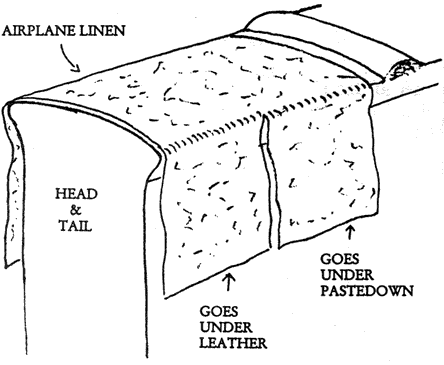
Volume 24, Number 6
Apr 2001
Board Reattachment
by David Brock
This is a technique I have been using at Stanford for the past 2
years to reattach the boards of leather covered tightbacked books,
sewn on raised bands. It involves lifting the spine leather, board
leather and pastedowns at the head and tail only.
The steps are as follows:
- At the head and tail spine panels, make a cut through the
leather near the base of the band, going from shoulder to shoulder.
- Lift the spine panels.
- Pastewash the spine to remove any deteriorated spine linings and
adhesive.
- Paste a light Japanese paper lining on the spine.
- When the Japanese paper lining is dry, secure loose or broken
endbands with thread.
- Adhere with PVA an airplane linen or cotton lining. The cloth
should be cut on the bias and extend 1/2 to 1 inch beyond the
shoulders, and go from near the base of the band to the end of the
spine. If the spine has endbands, extend the cloth onto the
endbands to help anchor them a little more strongly to the
textblock. It is important to work the PVA well into the cloth, as
the strength of this mend depends in part upon a strong bond between
the cloth and the text spine. The cloth can be dampened slightly
during boning to achieve greater adhesion.
- Determine now if further spine linings are needed to support the
spine when the book is opened.
- Lift the leather and pastedowns of the boards at the head and
tail.
- Cut the extensions of the linen lining in half, and fray out the
ed

- Place the boards in position on the book. Using PVA, adhere the
outer half of the extensions to the boards, going underneath the
lifted leather. Allow to dry.
- Open the boards and glue (PVA) the inner half of the extensions
to the boards, going underneath the lifted pastedowns. When dry,
readhere the pastedowns.
- Before gluing down the lifted leather, adhere a wet-torn strip
of Japanese paper over the linen showing in the joint. I usually use
a heavyweight Uda. This strip should begin slightly underneath the
lifted board leather and extend a little way onto the spine. This
will hide the weave of the linen and add strength to the joint.
Color the Japanese paper to match the leather with artist's acrylics
mixed in a little methyl cellulose. Mixing the acrylics in methyl
cellulose slows down their quick drying time and makes their
application easier.
- Readhere the lifted board leather and spine panels.
- Open the boards and paste a strip of suitable weight Japanese
paper in the hinge area, running from head to tail and from the base
of the shoulder to the top of the board. This adds a little to the
strength of the attachment, and gives a neater appearance to the
inside of the covers. The narrow line of paper that shows in the
joint when the boards are closed can be colored with the acrylic
paint/methyl cellulose mixture to match the leather.
- If the joint edges of the spine panels at the head and tail are
visually distracting, a narrow strip of Japanese paper can be
adhered just over the edges and then colored to match the leather.
I've successfully used this method of board reattachment on large
(quarto) and small books, with a few variations depending upon the
weight and size of the book. While this technique doesn't entirely
replace leather rebacking in my conservation work, I'm finding that
I use it more often.
(David Brock is a Rare Book Conservator at Stanford University.)
![[Contents]](../../img/contbtn.gif)
![[Search]](../../img/srchbtn.gif)
![[Abbey]](../../img/abbbtn.gif)

